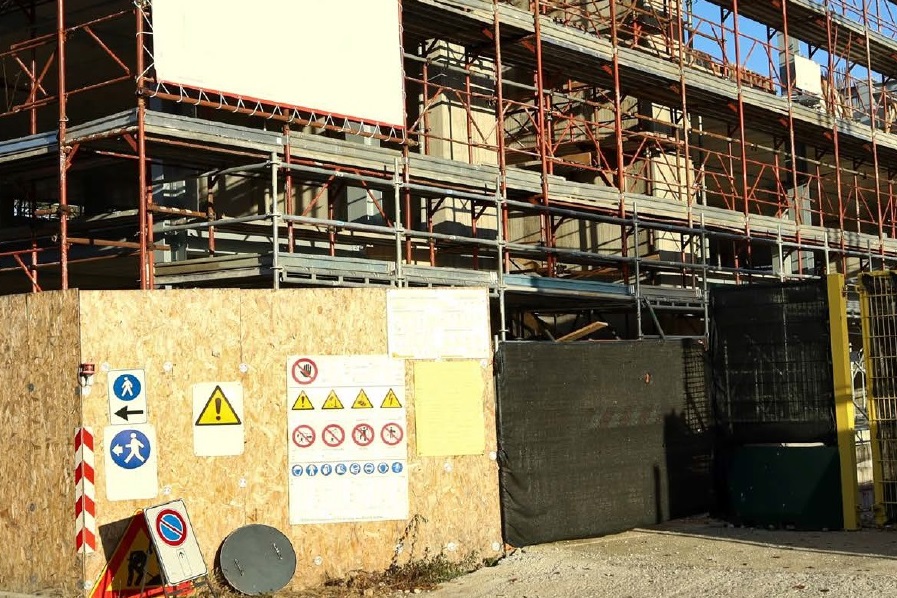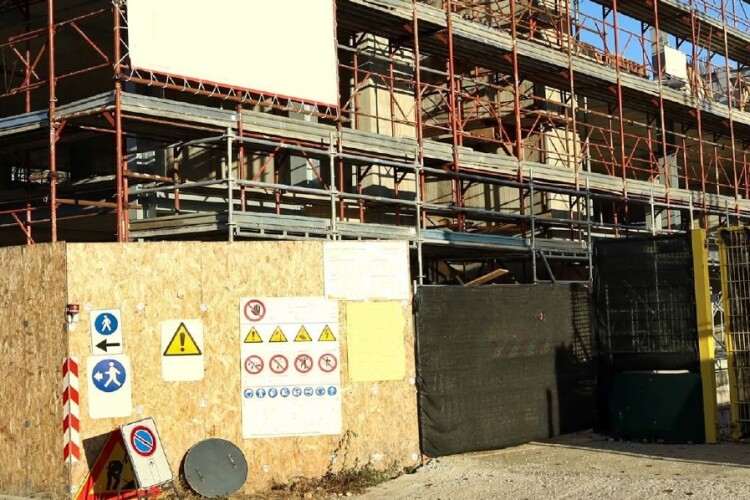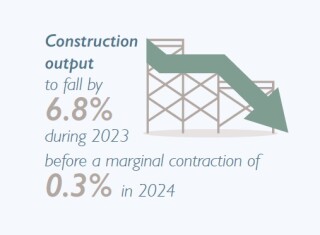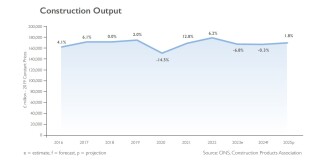Newest quarterly forecasts from the Building Merchandise Affiliation (CPA) put building output progress at minus 0.3% for 2024 – it’s a small contraction, however beforehand the CPA had been predicting a rebound in 2024.
On the optimistic facet, the CPA has very barely adjusted its 2023 forecast: three months in the past it predicted a 7.0% fall for 2023’s building output however now reckons a 6.8% fall.
The revisions are based mostly on the willpower that UK rates of interest at the moment are prone to have reached a peak that’s decrease than earlier expectations, however it’s now anticipated that they are going to stay at this stage for longer, till 2025, as a consequence of cussed inflation.
Consequently, the UK economic system is anticipated to flatline all through 2024, holding again the restoration in main sectors of building exercise reminiscent of new construct housing and restore, upkeep and enchancment (RMI) to 2025.
Even in infrastructure, output is now anticipated to fall marginally as extra roads tasks seem prone to be pushed again or cancelled than anticipated solely three months in the past. However, exercise will stay close to the present excessive ranges as a consequence of work persevering with on main tasks already on the bottom.
The headlines of the CPA’s autumn forecast are:
- Building output falls by 6.8% in 2023 and 0.3% in 2024
- Non-public housing output falls by 19.0% in 2023 and stays flat in 2024
- Non-public housing restore, upkeep and enchancment to fall by 11.0% in 2023 earlier than remaining flat in 2024
- Infrastructure output to fall by 0.5% in 2023 and fall by 0.1% in 2024
- Industrial output to rise by 3.5% in 2023 earlier than falling by 8.7% in 2024.
Non-public housing is each the most important building sector and the sector forecast to be the worst affected by prevailing financial circumstances this yr. The rise in mortgage charges for the reason that transient Liz Truss premiership in 2022 has led to house-builders reporting a 30-40% fall in demand and it has remained weak all through summer time and early autumn. Rates of interest and mortgage charges are anticipated to stay excessive for longer and adversely have an effect on demand all through subsequent yr, the CPA says. Consequently, after a 19.0% fall in completions and output this yr, completions are forecast to stay flat in 2024 with no progress till 2025. While the stability of dangers to non-public housing clearly stays on the draw back, a optimistic coverage stimulus within the chancellor’s autumn assertion would assist demand to begin to get better subsequent yr, the CPA stated.
 25-11.gif)
Non-public housing RMI is the second-largest building sector and exercise continues to be on a common downward development after the ‘race for area’ spike between 2020 and 2022 triggered by the lockdowns and dealing from house. Non-public housing RMI output is forecast to fall 11.0% this yr. As with new construct housing, the weak financial backdrop in 2024 will restrict the tempo of restoration, with a weaker housing market decreasing transactions-related enhancements and a notable fall in new planning purposes for bigger enhancements work. This can hold building output flat in 2024, which is a downgrade from the two.0% progress anticipated within the CPA’s summer time forecasts. Vitality-efficiency retrofit – primarily insulation and photo voltaic photovoltaic work – stays sturdy regardless of questions over authorities programmes reminiscent of ECO4, the Nice British Insulation Scheme and the Boiler Improve Scheme.
Within the third-largest sector, infrastructure exercise stays sturdy down on the bottom as a consequence of work persevering with on main tasks reminiscent of HS2, the Thames Tideway Tunnel and Hinkley Level C. Nevertheless, extra roads tasks are being delayed or cancelled than anticipated in the summertime forecasts and new tasks proceed to be delayed as rising prices jeopardies viability. The affect of the federal government’s determination to cancel HS2 north of Birmingham is proscribed as nearly all of this work was deliberate to happen past the forecast interval. Equally, the £36b of alternative tasks promised by the prime minister are unlikely to begin earlier than 2029, on the earliest, in the event that they happen in any respect. Total, infrastructure output is anticipated to fall by 0.5% in 2023, from its present excessive stage, earlier than remaining broadly flat (minus 0.1%) in 2024.
CPA head of building analysis Rebecca Larkin stated: “With solely a few months left in a tough yr for building and searching ahead to 2024, the proof suggests it is going to nonetheless be some time earlier than the clouds start to carry. Each new construct housing and RMI have taken a big hit from rising rates of interest, falling actual wages and weak financial progress. Though additional rises in rates of interest now seem off the desk, the prospect of rising oil costs conserving inflation elevated suggests charges are prone to stay at peak for longer and all through subsequent yr. This can hold demand subdued for home purchases and enhancements. It’ll additionally create a step-change in financing prices in comparison with the record-low charges of the previous decade for brand spanking new industrial and industrial tasks that’s prone to restrict urge for food for funding and growth.
“With infrastructure now set for 2 years of flatlining exercise, it does shine a lightweight on the significance of main tasks as a driver of progress within the sector and for building general. Specifically, authorities’s chopping and altering on infrastructure spending choices this yr has eliminated roads, rail and offshore wind tasks from the near-term pipeline and has additional weakened the business’s confidence that authorities bulletins can translate into tangible supply.”
Received a narrative? Electronic mail information@theconstructionindex.co.uk




